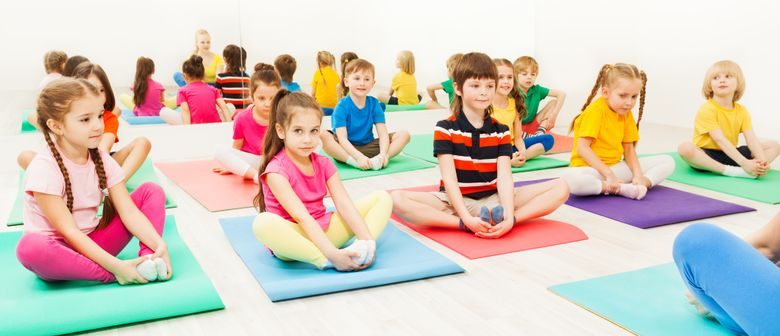Pose, Play, and Mindfulness
Exercise is a fantastic exercise that promotes mental focus, psychological equilibrium, and strength in the body. Although yoga is typically thought of as something for adults, yoga for children is a quickly expanding movement that offers kids minds as well as bodies all the advantages of yoga. Yoga for kids can be a very effective way to promote complete development, from aiding babies with their motor abilities to supporting kids focus and become more relaxed.
We shall examine the various advantages and methods of yoga for children in this guide. Additionally, we will explore the benefits of kids exercise poses, toddler yoga, preschool’ original yoga, and the fun of kids yoga activities.
When Is It Right Time to Introduce Yoga to Kids?
Although there is no “ideal” age for kids to start yoga, most experts concur that kids can start doing it right away as they understand basic directions and walk on their own. The greatest ways to introduce yoga to young children are through narrative and fun activities.
Yoga for toddlers can be introduced by parents and teachers with simple positions that are modelled after animals, breathing exercises, and interactive music. Early meditation and the development of motor skills can be fostered in kids in preschool through a more organised yet joyful method for yoga.
Kids Yoga Poses That Are Both Fun and Efficient
Child yoga poses are tailored to the stage of development of a child, flexibility, and focus span. These positions are humorous and approachable since they frequently imitate animals or other natural phenomena. Here are some traditional yoga positions for kids:
- Tree Pose: Promotes concentration and balance.
- Downward Dog: Builds leg and arm strength.
- Cobra Pose: Promotes comfort and flexibility.
- The cat-cow stretch improves body consciousness and spinal movement.
- Butterfly Pose: Excellent for hip release and energy relaxation.
Including storytelling in these yoga positions for youngsters keeps their minds active. For instance, practicing downward dog and cobra might become more thrilling and unforgettable if a session is transformed into a jungle trip.
Toddler Yoga That Is Creative
Toddler yoga should be lively, participatory, and very captivating. Sessions should be brief and jam-packed with excitement because toddlers are inherently inquisitive and active. For toddler yoga, movement-based games, singing, and visual aids are essential.
Using sounds and music to help them focus, you may guide young children through a sequence of positions modelled after farm animals. Toddler yoga frequently consists of:
- basic positions such as seated twists, happy baby, and child’s posture.
- Parental participation for bonding and safety.
- Sessions should be brief (10–15 minutes) to accommodate their attention span.
Toddler yoga is more than simply physical exercise; it’s a means of fostering emotional expression and self-control. Toddlers who practise regularly learn how to find peace even when they are overstimulated and how to take deep breaths when they are unhappy.
Yoga’s Advantages for Young Children

Preschool yoga adds more structured practices while building on the fundamentals of toddler yoga. Preschoolers are better able to follow directions and start to grasp the more complex facets of yoga, such breathing and relaxation.
Preschoolers can benefit from yoga in the following ways:
- Enhanced bodily awareness and motor coordination.
- improved patience and emotional control.
- Early attention and listening skills development.
- Techniques for managing transitions and stress.
Preschool yoga can incorporate storytelling yoga, inhaling with movement, and simple sun salutations. For instance, moon breathing, rockets pose, and star position could be used in a space exploration-themed session to engage both bodies and minds while teaching principles.
Yoga Games for Kids: Adding Fun to Yoga
Using children’s yoga games is one of the best ways to teach yoga. Games give kids a play component that keeps them engaged and inspired to practise. They also give children a means of collaboration, which improves their social and cooperative abilities.
Some child yoga games :
- Yoga Freeze Dance: When the music stops, you dance while freezing in a certain stance.
- Animal Yoga Parade: In a parade-style setting, kids imitate the movements and sounds of animals.
- Yoga Story Adventure: Children act out each scene with poses as they embark on a yoga trip through a story.
The secret to long-term involvement and enjoyment with kids yoga games is that they make yoga feel more like leisure than workout.
Including Yoga for Children in Schools and at Home
Kids can be introduced to yoga in both home and school settings. With mats, picture books, and props, parents may set up a little yoga area at home. Children and yoga become a bonding activity that promotes mindfulness for the entire family.
Yoga for kids can be offered as an independent course or as a component of exercise classes in schools. Yoga positions for children can be used by teachers as mind breaks, morning rituals, or during changes. Toddler and early primary schoolers who practise yoga benefit from a calmer classroom atmosphere, increased focus, and a decrease in behavioural problems.
How to Maintain Children’s Interest in Yoga
It’s crucial to keep kid-friendly yoga enjoyable and innovative. Here are a few methods for doing that:
- Sessions with a theme include fairy tale yoga, seaside adventure, or jungle day.
- Songs and music: Incorporate chants and rhymes into your positions.
- Props: To provide variation, use yoga cards, plush animals, or scarves.
- Art and crafts: Creating yoga dice or sketching their favourite positions.
It’s crucial to keep the tone relaxed and the sessions brief while doing yoga with young children, especially newborns and children. Allow them to be creative without correcting every action; expressiveness and inventiveness are just as important as accuracy.
Children’s Breath and Calm
Kids yoga teaches the fundamentals of attention in addition to movement. Young children can learn how to self-soothe and control their emotions by practicing basic respiration exercises like “balloons breath” or “smell the petals as they blow the candle.”
- Children’s training in mindfulness could involve:
- Guided visualisation: An adventure in the forest or on the beach.
- Listening games: Paying attention to the sounds in their environment.
- Breathing buddies: observing the rise and fall of a plush animal placed on the abdomen.
These behaviours develop into skills that kids can use in relationships, school, and eventually in life.
Conclusion: Developing thru Yoga
Beyond the mat, yoga has several advantages for children. It fosters self-assurance, serenity, and inventiveness. The method gives kids lifetime skills, if it’s through disciplined kids yoga poses, creative toddler yoga, concentrated preschool yoga or happy kids yoga games.
Childhood yoga is more than just a fad; it’s a comprehensive strategy for developing contented, even, and healthy youth. So unfold the mat, do a tree position, and start your child’s yoga adventure now.

